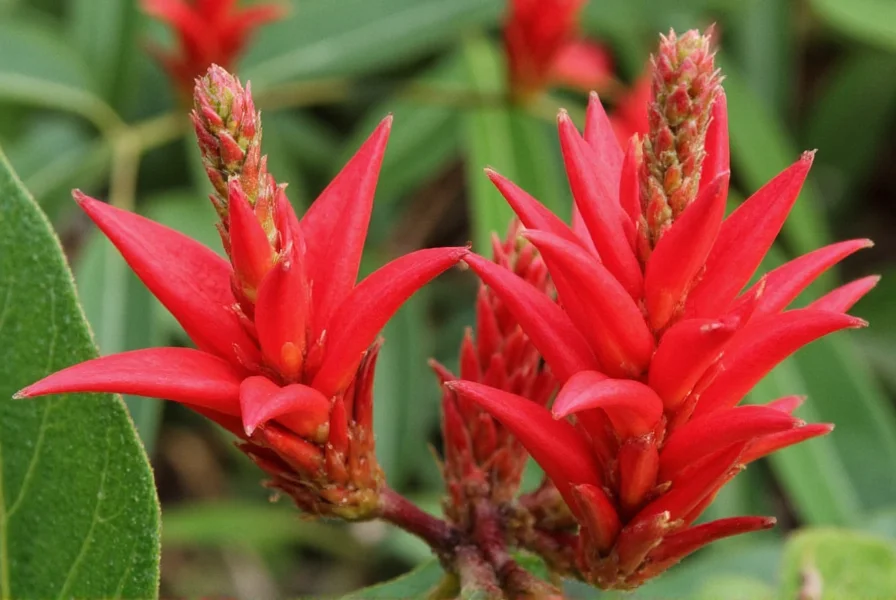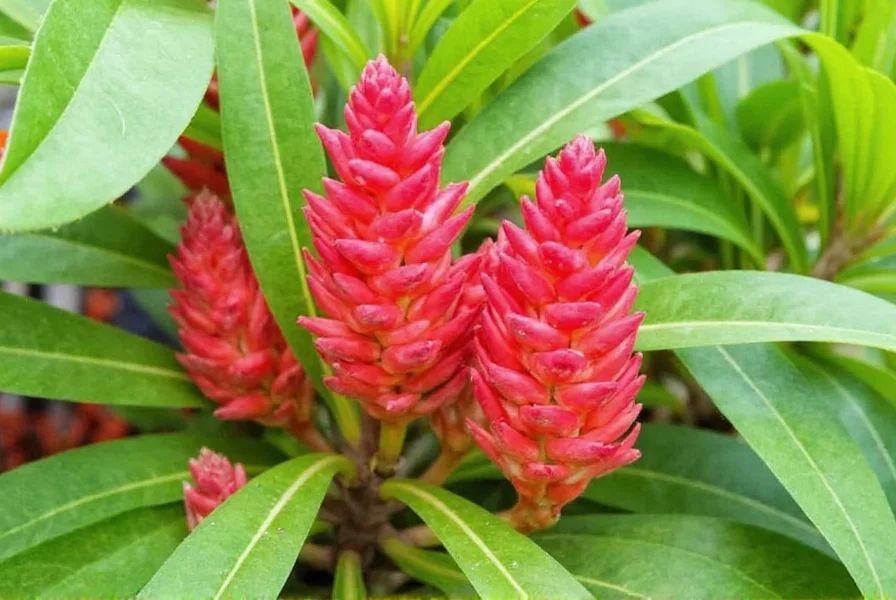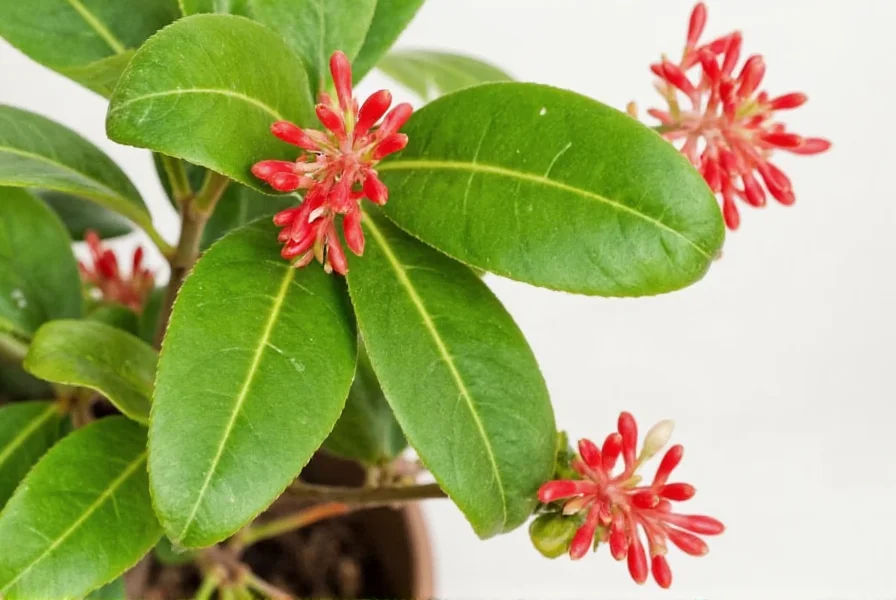
Understanding the Red Ginger Plant: Nature's Tropical Jewel
Gardeners across tropical and subtropical regions prize the red ginger plant for its dramatic visual impact and relative ease of care. Unlike culinary ginger (Zingiber officinale), this species belongs to the Alpinia genus and offers purely ornamental value with its spectacular floral displays that can last for months.
Botanical Profile and Identification
The red ginger plant, scientifically known as Alpinia purpurata, features distinctive characteristics that set it apart from other ginger varieties. Mature plants typically reach 6-12 feet in height with lush, banana-like leaves that create a dramatic tropical effect. The most recognizable feature appears in summer through fall when cone-shaped inflorescences emerge, displaying vibrant red bracts that gradually open to reveal small white or pale yellow flowers.
Many gardeners confuse red ginger with other tropical species, but its unique growth pattern provides clear identification markers. The plant grows from rhizomes rather than true roots, sending up multiple pseudostems that create a dense clump over time. Each flowering stem emerges separately from the rhizome, allowing for continuous blooming throughout the growing season when properly maintained.
Growing Requirements for Optimal Performance
Successful red ginger plant care requires understanding its natural habitat preferences. These plants evolved in the dappled light of tropical forest understories, making them perfectly suited for partial shade conditions in home landscapes. Direct afternoon sun can scorch their leaves, while complete shade reduces flowering.
| Growing Factor | Optimal Conditions | Tolerance Range |
|---|---|---|
| Temperature | 70-90°F (21-32°C) | Survives brief dips to 50°F (10°C) |
| Soil Type | Rich, well-draining loam | Tolerates clay with amendments |
| Water Needs | Consistent moisture | Intolerant of drought |
| pH Level | 5.5-6.5 (slightly acidic) | 5.0-7.0 acceptable |
Planting and Propagation Techniques
For best results when establishing red ginger plants, plant rhizomes in spring after the last frost. Position them horizontally with the growth buds facing upward, covering with 1-2 inches of soil. Space plants 3-5 feet apart to allow for their eventual spread. The most reliable propagation method involves dividing mature clumps during the active growing season, ensuring each division contains both rhizome sections and visible growth points.
Gardeners in USDA zones 9-11 can grow red ginger outdoors year-round, while those in cooler climates should consider container growing. Potted plants require well-draining potting mix and containers with ample drainage holes. Move containers indoors when temperatures drop below 50°F (10°C) to protect the rhizomes from cold damage.
Seasonal Care and Maintenance
Red ginger plant care requirements change throughout the year. During the active growing season (spring through fall), maintain consistent soil moisture and apply balanced fertilizer every 4-6 weeks. As temperatures cool in fall, gradually reduce watering to prepare the plant for potential dormancy. In tropical regions, red ginger typically remains evergreen, while plants in marginal zones may die back to the ground during cooler months.
Pruning needs remain minimal with red ginger. Remove spent flower stalks to encourage additional blooming and cut back damaged or yellowing leaves at their base. Avoid cutting healthy green foliage, as this reduces the plant's energy production capacity. In spring, clear away any winter debris to prevent pest harborage and promote new growth.
Common Challenges and Solutions
While generally trouble-free, red ginger plants occasionally face specific issues. Yellowing leaves often indicate overwatering or poor drainage—adjust your watering schedule and ensure proper soil conditions. Lack of flowering typically results from insufficient light or nutrients; move the plant to a brighter location with filtered sun and apply a phosphorus-rich fertilizer.
Pests rarely cause significant damage but watch for spider mites in dry conditions and scale insects on the leaves. Treat infestations with insecticidal soap or horticultural oil rather than harsh chemicals that might damage the plant. Root rot represents the most serious threat, usually developing from prolonged soil saturation—improve drainage immediately if you notice wilting despite moist soil.
Landscaping Applications and Design Considerations
The red ginger plant shines in tropical and subtropical landscape designs. Use it as a dramatic focal point near patios or water features, where its vibrant bracts create stunning visual interest. Group multiple plants together for a lush, jungle-like effect or intersperse with other tropicals like bird of paradise and heliconia for varied texture and color.
Consider these strategic placement tips for maximum impact:
- Position against dark green foliage to make the red bracts pop
- Plant along pathways where visitors can appreciate the flowers up close
- Use as a backdrop for smaller tropical plants
- Place near seating areas to enjoy the subtle fragrance
Understanding Red Ginger's Non-Edible Nature
Many gardeners wonder about the edibility of red ginger plants. Unlike culinary ginger (Zingiber officinale), Alpinia purpurata offers no significant culinary value. While not toxic, the rhizomes lack the characteristic flavor compounds found in true ginger. Some traditional medicine systems use related Alpinia species, but red ginger specifically has limited documented medicinal applications. Always consult with a qualified herbalist before considering any plant for medicinal purposes.

Seasonal Flowering Patterns and Expectations
Red ginger plants typically begin flowering in late spring and continue through fall in optimal conditions. Each inflorescence develops over several weeks, with the red bracts opening sequentially to reveal the delicate flowers within. The entire flowering process creates a long-lasting display, as new bracts continue to open while older flowers fade.
Understanding red ginger plant flowering season helps set realistic expectations. In tropical climates with consistent warmth and humidity, flowering may occur year-round. In subtropical regions, the main display appears during warmer months. Flower production directly correlates with the plant's energy reserves—mature, well-established clumps produce significantly more blooms than newly planted rhizomes.











 浙公网安备
33010002000092号
浙公网安备
33010002000092号 浙B2-20120091-4
浙B2-20120091-4